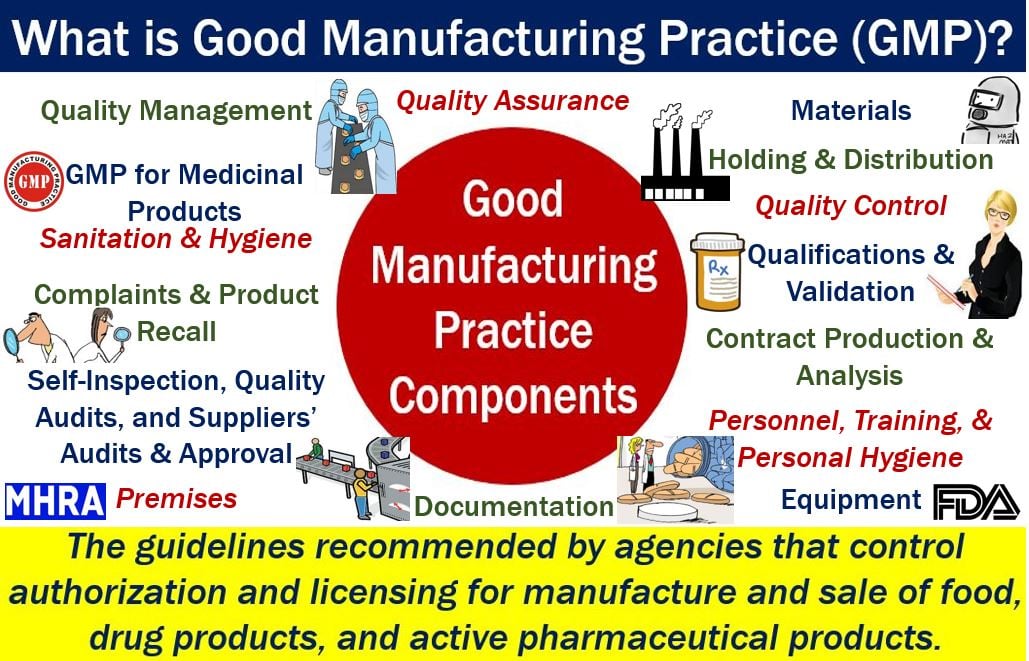Good Manufacturing Practice or GMP is a system for ensuring that manufacturers produce goods consistently and in a controlled way. Companies and organizations must produce their goods according to quality standards. GMP contains basic preventive guidelines for factory and facility operations. In other words, it is part of a system that aims to maintain high standards.
Good manufacturing practice aims to minimize risks that we cannot eliminate through testing the final products.
Good manufacturing practices are the guidelines that regulatory agencies recommend for the producers and sellers of drugs and active pharmaceutical products. The guidelines are also recommendations for the manufacturers and sellers of food.
We can also use the term in the plural with basically the same meaning, i.e., good manufacturing practices.

Good manufacturing practice subject to change
Responsible employees need to ensure GMP compliance. Since methods and regulations often change, we sometimes refer to GMP as CGMP, which stands for Current Good Manufacturing Practice(s).
To further enhance food safety, many of these companies integrate GMP with ISO quality management standards, creating a comprehensive framework for product excellence.
This synergy between GMP and ISO protocols represents a proactive approach to quality assurance, aiming to exceed rather than merely meet regulatory expectations.
Since GMP regulations and methods are constantly changing, industries need to update their skills and knowledge continually . Otherwise, they will not be able to keep up and implement the latest techniques.
According to regulatory agencies, good manufacturing practice guidelines are applied to:
- Hygiene.
- The protection of the environment, i.e., preventing contamination.
- The control of the manufacturing process.
- Distribution methods.
- The investigation of deviations from GMP rules and regulations.
- The control of procedures and record-keeping.
- Distribution methods.
- Regarding drugs, which procedures to follow when there is a recall or investigation of defects.
Regulatory agencies across the world oversee many different types of ‘practices.’ For example, they oversee good agricultural practices, good clinical practices, and good laboratory practices.
Consumption of food and drugs
Good manufacturing practice guidelines aim to ensure that drugs and food are safe for human consumption. GMP has guidelines for manufacturing, testing, and quality assurance.
GMP for food and drugs
The aims of the guidelines include safeguarding consumer health. They also aim to protect patients and ensure that manufacturers produce top-quality medical devices.
In fact, in some countries, a drug may have passed all specification test, but if it violated GMP guidelines, regulators might classify it as ‘adulterated.’
Good manufacturing practice – regulatory agencies
In the United States, the Food and Drug Administration (FDA) enforces GMPs under Title 21 CFR. The FDA uses the term ‘Current Good Manufacturing Practices’ when describing these guidelines.
The FDA is America’s regulatory agency for drugs, cosmetics, food, tobacco products, and medical devices.
Since 2010, in the US, there has been a set of guidelines just for manufacturers of dietary supplements.
In the EU (European Union), national regulatory agencies perform GMP inspections. For example, in the UK, the regulatory agency is the Medicines and Healthcare Products Agency (MHRA).
In Canada, the Drug Good Manufacturing Practices Unit and the Health Products Food Branch Inspectorate oversee the enforcement of GMP guidelines. In Australia, it is the Therapeutic Goods Administration (TGA), and in South Africa the Medicines Control Council (MCC).
India’s state-level agency is the Food and Drugs Administration (FDA). India’s FDA reports to the Central Drugs Standard Control Organization.
In most countries, food processing companies comply with GMP guidelines alongside other systems, such as HACCP. HACCP stands for Hazard Analysis Critical Control Point.
Examples sentences
Below are some example sentences containing the term “Good Manufacturing Practice,” to help you see how we can use the term in context.
- “To ensure the safety and efficacy of our pharmaceutical products, we strictly adhere to Good Manufacturing Practice regulations at every stage of production.”
- “The audit concluded that the facility’s adherence to Good Manufacturing Practice standards was exemplary, which greatly reduced the risk of product contamination.”
- “During the training program, all new employees are thoroughly educated on the principles of Good Manufacturing Practice to maintain our commitment to quality.”
- “The recent recall of the medical device was due to a breach in Good Manufacturing Practice, highlighting the importance of stringent quality control systems.”
- “Good Manufacturing Practice is not just a regulatory requirement; it is our ethical obligation to guarantee that our customers receive products of the highest standard.”
- “The integration of automation in our manufacturing process has been designed to complement our Good Manufacturing Practice protocols, enhancing consistency and precision.”
- “As part of our commitment to continuous improvement, we regularly review and update our procedures to align with the latest Good Manufacturing Practice guidelines.”
